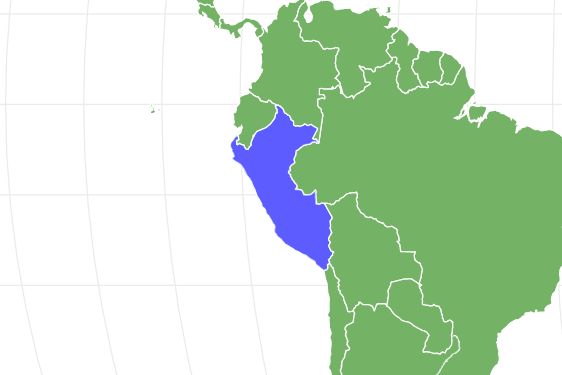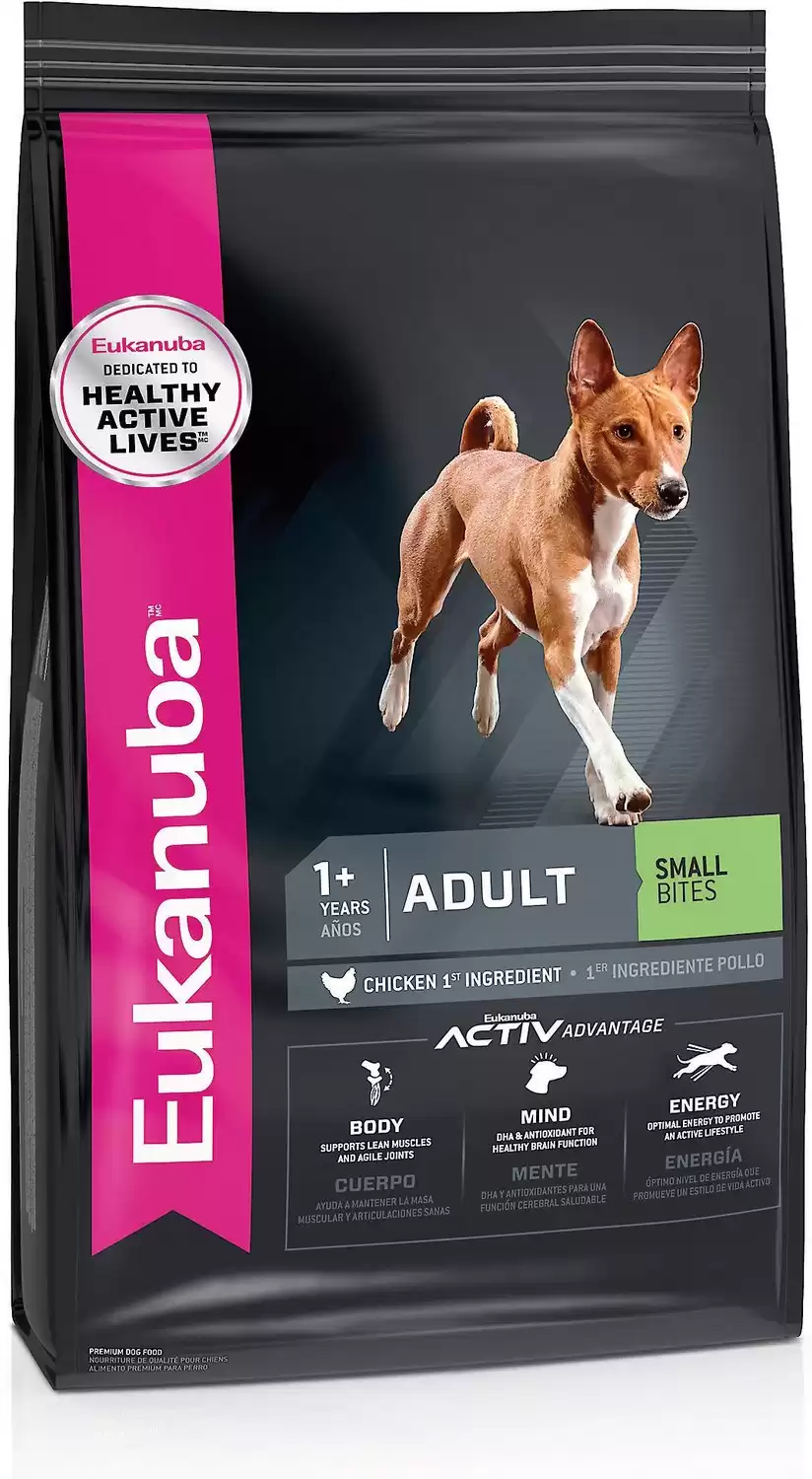Peruvian Inca Orchid
Canis lupus
The Peruvian Inca Orchid is the national dog of Peru
Advertisement
Peruvian Inca Orchid Scientific Classification
- Kingdom
- Animalia
- Phylum
- Chordata
- Class
- Mammalia
- Order
- Carnivora
- Family
- Canidae
- Genus
- Canis
- Scientific Name
- Canis lupus
Read our Complete Guide to Classification of Animals.
Peruvian Inca Orchid Conservation Status
Peruvian Inca Orchid Facts
- Name Of Young
- Puppy
- Fun Fact
- The Peruvian Inca Orchid is the national dog of Peru
- Estimated Population Size
- about 1,000
- Most Distinctive Feature
- their hairlessness
- Other Name(s)
- Inca Hairless Dog, Viringo, Dielmatian and Perro Sin Pelo del Per
- Temperament
- Loyal, affectionate, and dignified
- Litter Size
- 3-5 puppies
- Diet
- Omnivore
- Common Name
- Peruvian Inca Orchid
- Origin
- Peru
Peruvian Inca Orchid as a Pet:
- General Health
- Energy Level
- Shedability
- Trainability
- Intelligence
- Tendency to Chew
- Size
- Family and kid friendliness
- Yappiness / Barking
- Moderate
- Hypoallergenic
- Yes
- Separation Anxiety
- High
- Preferred Temperature
- Average climate
- Exercise Needs
- Moderate
- Friendly With Other Dogs
- Moderate
- Pure bred cost to own
- $1,000 to $1,500 on average
- Dog group
- Hound
- Male weight
- - lbs
- Female weight
- - lbs
This post may contain affiliate links to our partners like Chewy, Amazon, and others. Purchasing through these helps us further the A-Z Animals mission to educate about the world's species.
View all of the Peruvian Inca Orchid images!
The Peruvian Inca Orchid goes by many names, including perro sin pelo de Peru (Peruvian hairless dog), the perros flora (flower dog), the Inca hairless dog, and the Peruvian viringo. Since its body radiates a lot of heat, it was once used as bed warmers during the night. It was supposedly imbued with mystical properties to stop headaches or cure arthritis.
The Peruvian Inca Orchid (also known as the Peruvian Hairless Dog) is an ancient breed, dating back more than a thousand years in Peru. Depictions of this breed first appeared on the local pottery of the Moche people by around the year 750 AD. When the Spanish conquistadors arrived, this was one of the major breeds prized by the Incan Empire. While the Incans did not originally breed this dog, it came to be associated with them. This breed declined swiftly following the end of their empire, and the remaining survivors were mixed heavily with Eurasian dogs; it has even lost the unique genetic signature that would identify it as a pre-contact American breed.
See all of our expert product reviews.
The Peruvian Inca Orchid is considered to be a sighthound, adept at hunting small rodents. It is characterized by a sleek and athletic body, long ears, and a thin and sinewy tail. Hairlessness (except on the head, feet, and tail) is the breed’s most important physical characteristic, but coated varieties can also appear, even within the same litter as hairless dogs. The coated variation is the result of a recessive trait.
The dog needs to inherit two recessive traits from both parents to grow a full coat of fur. If it inherits a dominant hairless trait and a recessive-haired trait, then it will result in a hairless dog. If the dog inherits two copies of the hairless trait, then the fertilized egg will die shortly after. This means all surviving dogs will have at least one recessive-haired trait. Any colors are accepted, including white, pink, tan, gray, black, and brown.
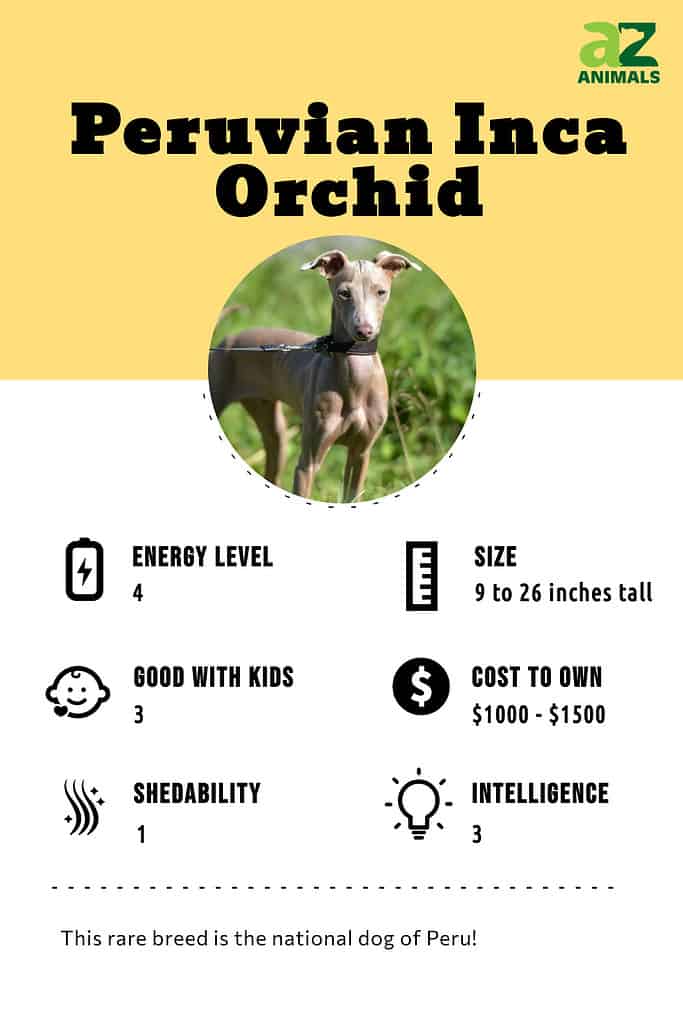
Peruvian Inca Orchid vs. Xoloitzcuintli
The Xoloitzcuintli (or Xolo for short) is another ancient hairless breed, this one hailing from Mexico. It bears a strong resemblance to the Peruvian Inca Orchid both in its temperament and physical characteristics. The untrained eye may accidentally mistake them for each other. They have similar builds, similar sizes, and come in both haired/coated and hairless varieties.
3 Pros And Cons Of Owning A Peruvian Inca Orchid
| Pros! | Cons! |
|---|---|
| Super Affectionate: The Peruvian Inca Orchid loves the company of people. | Sensitive Skin: This breed is susceptible to skin irritation and burns. |
| Minimal Grooming: This breed has very little hair to manage. | High Mental Needs: To keep its boredom at bay, this breed needs to have plenty of activities to do during the day. |
| Excellent Health: The majority of dogs from this breed should have few developmental or inheritable conditions. | Strong Prey Drive: The Peruvian Inca Orchid has a strong habit of chasing after smaller animals. |
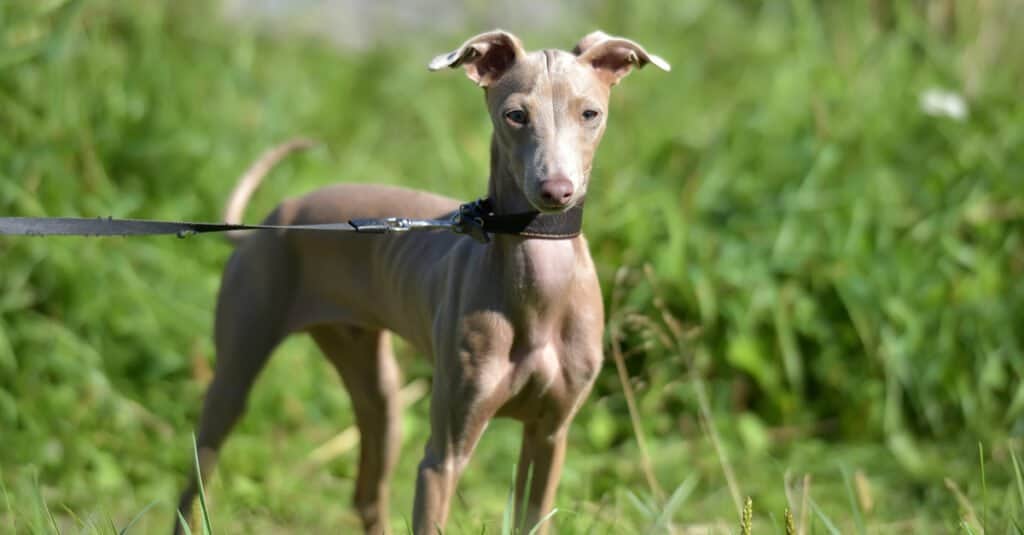
©Anna Krivitskaya/Shutterstock.com
Size And Weight
The Peruvian Inca Orchid comes in three basic sizes: small, medium, and large. The small version generally weighs between 8.5 and 17.5 pounds. The medium version weighs 17.5 to 26.5 pounds. And the large dog weighs 26.5 to 55 pounds.
Health and Entertainment for your Peruvian Inca Orchid
See all of our expert product reviews.
| Height (Male): | 9 to 26 inches |
| Height (Female): | 9 to 26 inches |
| Weight (Male): | 8.5 to 55 pounds |
| Weight (Female): | 8.5 to 55 pounds |
Common Health Issues
The Peruvian Inca Orchid has a good lifespan of 12 to 14 years, but it is prone to developing several different health problems, including acne, skin lesions, epilepsy, cancer, irritable bowel disease, and missing teeth. This dog will need routine checkups at the vet to catch health problems as early as possible. In summation, these are the most common health problems with the PIO:
- Acne
- Skin Lesions
- Cancer
- Irritable Bowel Disease
- Epilepsy
Temperament
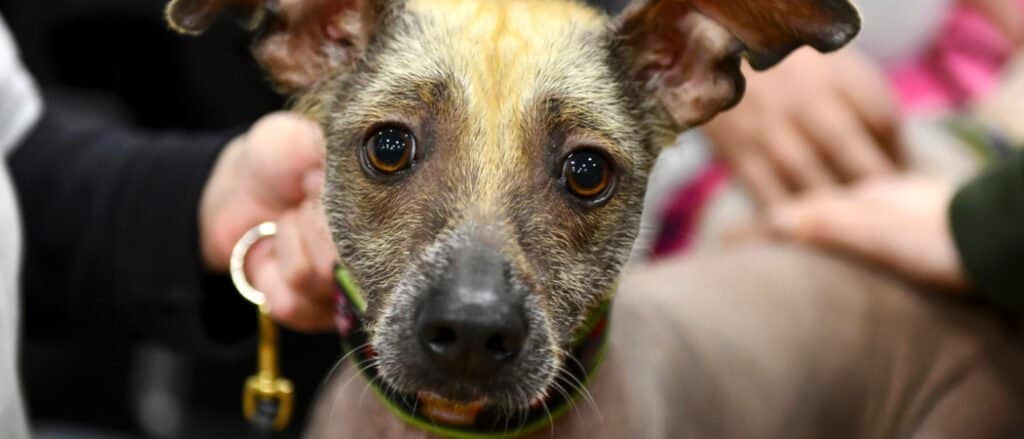
Peruvian Inca orchids can have a variety of different temperaments and need constant mental stimulation.
©nyker/Shutterstock.com
The Peruvian Inca Orchid has a “primitive” personality; this means it can exhibit a wide range of different temperaments, from docile to more feral. It’s also a sensitive and affectionate dog that loves people and always thrives in its owner’s presence. This is an indoor dog; it should not stay alone outdoors for long periods without supervision, even if you’re somewhere nearby. It also needs constant mental stimulation throughout the day. Otherwise, it could resort to annoying and destructive behavior.
How To Take Care Of The Peruvian Inca Orchid
The Peruvian Inca Orchid is best for experienced owners that have enough time to shower it with constant company and attention. It does well in both apartments and houses, but it should live indoors for most of the day.
The Best Dog Food For Peruvian Inca Orchids
The Peruvian Inca Orchid will need a few cups of high-quality dog food per day, based on the dog’s age, size, and activity level. Both commercial dog food and home-prepared food should suffice to satisfy your dog’s needs.
At A-Z Animals, we say the best dog food for Peruvian Inca Orchids is Eukanuba Adult Small Bites Dry Dog Food.
This quality chicken recipe has vitamins E and A for smooth skin and coat. There’s a blend of natural fiber and prebiotics to aid digestion, plus polyphosphate in a special crunchy kibble that keeps teeth clean from tartar and plaque.
Find Eukanuba Small Bites dog food on Chewy and Amazon.
- Small bite blend suited for dogs with smaller jaws
- DHA and antioxidants for brain health
- High protein to provide energy
- Supports lean muscles and healthy joints
Maintenance And Grooming
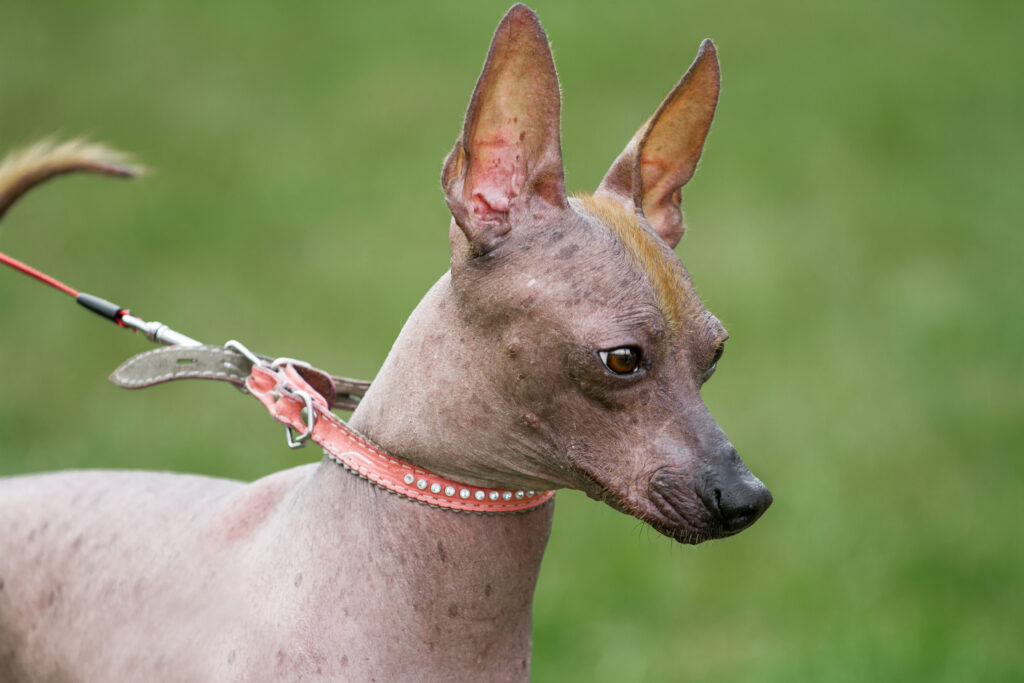
Peruvian Inca orchid doesn’t need much grooming but the hairless version should be wiped frequently with a damp cloth.
©Vera Reva/Shutterstock.com
The Peruvian Inca Orchid should do well with minimal grooming. The hairless version needs to be wiped down with a damp cloth frequently to remove dirt and grime, and it will also need occasional baths every week or two to prevent the skin from developing blemishes and acne. In addition to these normal grooming habits, the nails will need a trim about once a month, or whenever necessary, to prevent them from splitting, cracking, or clicking on the floor. Check the ears every so often for signs of infection and then cleaned out with a cotton swab and cleansing solution. Brush the teeth frequently as well. When you venture outside into the sun, the dog will need proper sunscreen or clothing to protect its fragile skin.
Training
The Peruvian Inca Orchid should be fairly easy to train with enough positive reinforcement methods, but owners may need to commit a substantial amount of time to work with them. Patience and consistency are a must to get the most out of them.
Exercise
The Peruvian Inca Orchid needs about 30 minutes or more of exercise per day. It enjoys indoor playtime, walks around the block, and free running, preferably in a fenced yard. Be careful about letting this dog off the leash, because it does tend to chase small animals around.
Puppies
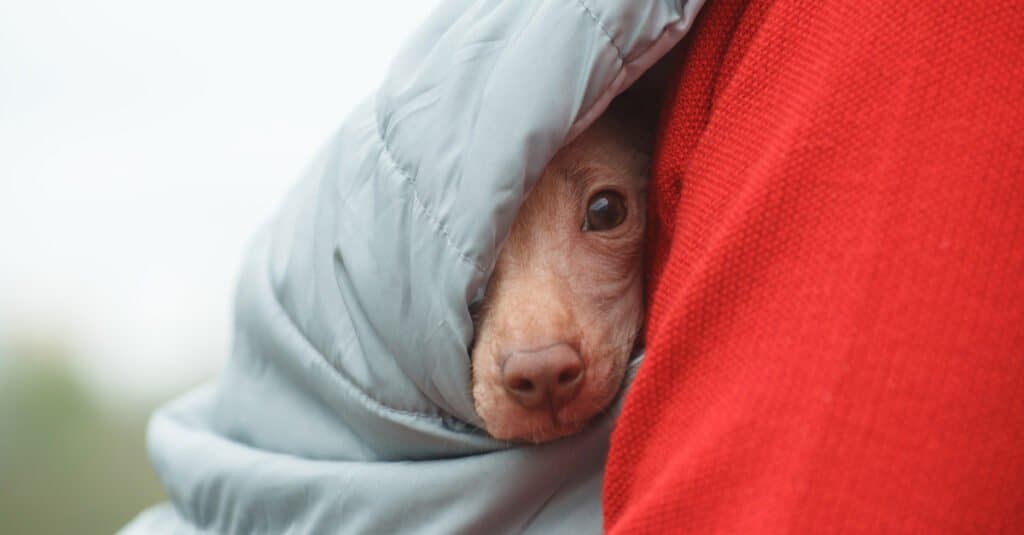
©katamount/Shutterstock.com
Peruvian Inca Orchid puppies need to begin the process of socialization, housetraining, and boundary setting as early as possible. It should gradually ease into more advanced training after a few months. Crate training, while not mandatory, can help quite a bit with housebreaking and early behavioral issues. You should also try to get this dog out of the house and introduce it to as many new situations as possible.
In addition to all of this, this breed does have a few unique personality quirks that owners should be aware of. According to the American Kennel Club, rough play should be discouraged as a puppy, because it could promote aggressive behavior later on. Puppies also do best with children and other animals if raised with them from a young age.
The Peruvian Inca Orchid And Children
This breed is generally not ideal for homes with smaller children. They will do best in households with older, more responsible children. Adults should supervise all interactions between this breed and their kids.
Dogs Similar To The Peruvian Inca Orchid
The PIO resembles several other breeds of small to medium-sized hairless dogs around the world.
- Xoloitzcuintli: Named after Xotlotl, the Aztec’s dog-headed god of fire and lightning (and the guide for the souls of the dead), the Xoloitzcuintli (also known as the Mexican hairless dog) is an affectionate, smart, and sensitive breed that looks like the Peruvian Inca Orchid. It comes in three different sizes: toy, miniature, and standard.
- Chinese Crested Dog: This small toy breed is almost completely hairless except for tufts of hair around the head, tail, and ankles. Its lively and affectionate personality should endear itself to people of all ages.
- Whippet: The Peruvian Inca Orchid isn’t actually related to the whippet at all, but it does have a similar sleek body and strong desire to chase prey.
Famous Peruvian Inca Orchid Dogs
The Peruvian Inca Orchid is unfortunately quite rare outside of its native country. There are few famous examples of it in the world.
Popular Names For The Peruvian Inca Orchid
If you still haven’t settled on a good dog name, then you might want to consider the following options:
- Pedro
- Teresa
- Eva
- Carlos
- Luna
- Lucas
- Bella
- Chester
- Mia
- Sam
Peruvian Inca Orchid FAQs (Frequently Asked Questions)
What is a Peruvian Inca Orchid?
The Peruvian Inca Orchid is an ancient breed hailing from Peru. It is highly affectionate, sensitive, and loyal to its owner.
What is the price of a Peruvian Inca Orchid?
The price of a new puppy can vary widely depending on a number of factors, including availability, pedigree, and health of the dog. Potential owners should probably expect to pay at least $1,000, sometimes substantially more, though it might be possible to find one for less. The price of adopting a PIO is normally no more than a few hundred dollars, assuming you’re lucky enough to find one in a shelter or with a willing seller. Mixed breed dogs will generally cost a lot less as well.
Can a Peruvian Inca Orchid be left alone?
This breed should not be left alone for more than a few hours at a time. If you do plan to leave it alone, then it must be kept indoors. You should ideally have someone check on your dog throughout the day.
How big is a Peruvian Inca Orchid?
The PIO usually grows no larger than 55 pounds and stands up to 26 inches around the shoulders.
How long do Peruvian Inca Orchids live?
The PIO has an average life expectancy of 12 to 14 years, but with enough good care and luck, it can live several years longer.
How do I rescue a Peruvian Inca Orchid?
Because of their rarity, it’s probably a good idea to get in touch with a breed-specific rescue organization. They are most likely to have a rescued purebred PIO or a mixed dog.
How do I care for a Peruvian Inca Orchid?
The Peruvian Inca Orchid isn’t too difficult to care for. It will only require a moderate amount of exercise, minimal grooming with a damp cloth, occasional baths, nail trimmings, ear cleanings, and teeth brushing. While care is relatively easy, owners will need to set aside a substantial amount of time throughout the day, because it can grow bored easily if left to its own devices.
Why is it called a Peruvian Inca Orchid?
According to a legend, the Spanish named these dogs Perros flora because they were found near caves with wild orchids. American dog breeder Jack Walklin encountered this breed while visiting Peru in 1966 and came up with the equally descriptive name of Peruvian Inca Orchid.
Thank you for reading! Have some feedback for us? Contact the AZ Animals editorial team.
Sources
- American Kennel Club, Available here: https://www.akc.org/dog-breeds/peruvian-inca-orchid/
- MF, Available here: https://www.mentalfloss.com/article/84719/10-lovable-facts-about-peruvian-inca-orchid
- Wag!, Available here: https://wagwalking.com/breed/peruvian-inca-orchid

